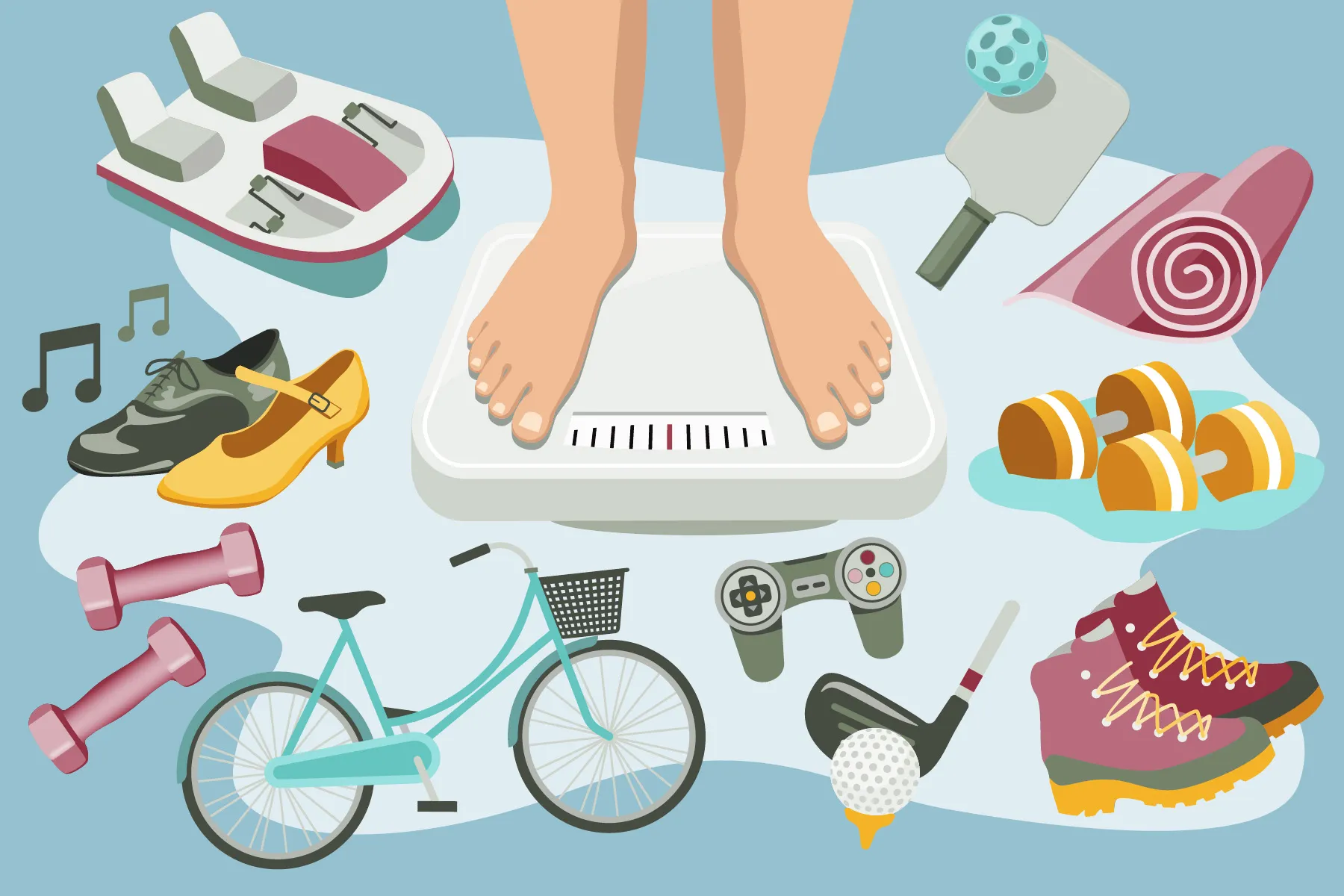Whether or not you have obesity, exercise is important for your health: physically and mentally. But getting enough can be hard. And you may face extra challenges when you’re overweight.
The good news is there are lots of workouts for you that are safe, effective, and fun.

How Is Exercise Different When You Have Obesity?
Those with larger bodies may feel that others are judging them in fitness-focused settings, said Mathias Sorensen, an exercise physiologist at the University of California, San Francisco. “That alone can create a negative spiral of lowered self-respect or self-esteem.”
But it’s important to realize that, when you’re working out, others are likely too focused on themselves to spend time judging. And if someone is unpleasant, it’s most likely a reflection of their own insecurities.
The physical challenges may also be tough to get used to. “It’s important to understand that there’s going to be significant physical discomfort, strain, fatigue, and frustration,” said Sorensen.
With some movements, you may have more pain in your joints with obesity because you’re carrying more weight. For this reason, it’s important to find movements that aren’t harsh on your body.
For example, you might want to avoid high speeds on the treadmill if you have joint pain, according to Matthew Kampert, DO, a sports medicine specialist from the Cleveland Clinic,. Increasing the grade instead of the speed of a treadmill can be a better option. And if it’s painful to squat, you can swap out the movement with a leg press instead. This will work almost all of the same muscles, but take some of the load off your joints.
10 Exercises for Larger Bodies
When you start a new type of exercise, Sorensen suggests you first ask yourself if you enjoy the activity. If not, find a better option. It’s easier to stick to a routine if you love it.
Get creative with workouts you choose. A few great options include:
Cycling. This can be an exciting way to get cardio. It can aid in weight loss if you put yourself in a caloric deficit. You can burn anywhere from 400 to 750 calories per hour while cycling.
It’s also low-impact on your body. If you don’t want to bike outside, cycle indoors on a stationary bike. To make it more interesting, stream your favorite show while you cycle.
Recumbent bikes can also be a great option. They have a wider seat as well as a back rest. The pedals are in front of your body. These bikes also tend to be more comfortable. They're a good choice if you have trouble with mobility or balance.
Sorensen suggests using this reward system: If you need the extra push, reserve TV time only for when you cycle.
Pedal boating. You might enjoy a day on the lake while getting some exercise using a pedal boat. This activity is similar to regular cycling, except you’re on water! If biking gets boring, a pedal boat can refresh your cardio routine. Plus, sitting down and cycling may be a great way to maintain balance and go at a pace that’s comfortable for you.
There are different pedal boat sizes and shapes. Some have larger seats, while others are narrower. You can search through different brands to find one that fits your needs best.
Hiking. Tap into your explorer side and go for a hike. Venture onto forested trails, or take an urban hike if you live in the city. Either way, hiking is a great way to get some physical activity and soak up the outdoors. Hiking can also improve your sleep and build strong bones and muscles.
Water aerobics. Exercising in the water can be a great way to lose weight. It also helps your heart and blood vessels and is easy on your joints. Water aerobics and swimming are great swaps if you can’t do weight-bearing activities like walking, running, or jogging. They’re also forms of resistance training, similar to weight training, because the water is pushing against your body.
Pilates, yoga, or tai chi. When you think of an exercise for weight loss, you might picture fast-paced movements. But slower, more relaxing workouts can also have benefits for obesity.
“These are all great exercises that can help with your mind-body connection and improve balance and flexibility,” said Sorensen.
Pilates can help lower your body weight and body fat.
Yoga can help boost your mood, lower stress, curb emotional eating, and build muscle mass. All of these can play a role in fat loss. Yoga can also lessen your joint pain, which can help you get more active in other areas, too.
Tai chi has been shown to lower your waist size, especially in middle-aged or older adults with obesity who carry most weight in their midsection.
Dancing. You can boost your fitness level with group dance classes or dance lesson videos at home. Dancing can help build your muscle tone, endurance, and strength.
Hip-hop, specifically, has been shown to help fitness levels in children who are overweight or have obesity.
Pickleball. This sport is similar to tennis, but a bit slower. It can be a great option if you don’t like faster-paced sports. Pickleball can lower your blood pressure, make you more flexible and agile, strengthen your muscles, and help control your weight.
Golfing. If you play golf regularly, it can help you stay in shape, lose body fat, and build endurance. It can be a great addition to your fitness routine. Instead of using a golf cart between holes, you might opt for a walk instead. This can be a simple way to add some more steps to your day. For an extra challenge, you can carry or pull your own clubs.
Strength training. This helps you build muscle, strengthen your bones, and manage your weight. You can start off with body weight movements and progress into resistance bands, free weights, or machine weights.
It’s always smart to ease into a workout to get the best results. “It's about consistency. Especially when you’re getting started. Don’t do too much,” said Kampert. “Focus on developing long-term habits to be successful. You don't wanna get an over-training injury.”
Video games that require movement. There are some video games that require you to walk, dance, or move around. As a part of your overall fitness plan, these games can help you get more steps in and boost your heart rate. That helps with weight management.
Talk to your doctor before starting any exercise program. That’s extra important when you have health conditions like obesity.
Why Is Exercise Good for You?
Boosting your fitness levels comes with many perks. You might focus on weight loss as the main benefit. But it’s just one of the many helpful effects of a regular workout program.
Exercise helps in many ways, including:
It aids your emotional/mental health. It helps release endorphins (natural chemicals in your brain) that help with anxiety and depression. It’s also a great way to help with your self-image.
“There's a lot of data that suggests exercising regularly will help boost your self-esteem and self-confidence, and improve your overall mood,” said Sorensen.
It sparks new friendships. Starting a new sport or activity can introduce you to like-minded people. You’ll connect with others who might be on a similar fitness journey as you.
“The self-determination theory helps understand how extrinsic (outer) motivation becomes intrinsic (inner) motivation,” said Sorensen. “One of the major parts of this theory is a sense of relatedness. Developing that is huge to creating a natural enjoyment for physical activity.”
It helps your heart health. Boosting your fitness – even a little bit – can lower your risk of heart-related issues by 10% to 30%, Kempert says.
An active lifestyle lessens your risk of heart disease, stroke, and high blood pressure. In addition to your heart health, regular exercise and physical activity lowers your risk of obesity-related conditions like diabetes and some cancers.
It helps maintain muscle mass while you age. As you get older, your muscle mass decreases.
“It’s important to build as much muscle as you can when you're young, and then maintain that muscle as you age,” said Kampert.
More muscle mass helps boost the calories you burn, even when you rest. If your goal is to lose weight, building and maintaining muscle mass can help.
Chat With Your Doctor First
Before you start any new exercise program, talk to your doctor. Health conditions, including obesity, can mean taking extra caution.
This is especially important if you tend to get dizzy (or take medicine that makes you dizzy or drowsy), aren’t able to keep good balance, or have a chronic or serious health condition (like obesity, asthma, high blood pressure, diabetes, or heart disease.)
To make an effective and safe workout plan, you can also get help from professionals like these:
- Physiatrists (or rehabilitation physicians). These are medical doctors who focus on treating bone, muscle, and nerve conditions that make you less able to move. They can help create an exercise program that’s helpful for you, especially if you’ve had recent surgery or injury, or you have another issue that affects your movement.
- Personal trainers. These certified experts can make sure you complete each exercise correctly. They can fix your form, teach you new exercises, and inspire you to reach your goals.
- Physical therapists or physical therapy assistants. These trained experts help you heal after an injury to your nerves, bones, or muscles, or if you have other health issues. They can be helpful if you have constant pain, or you’re recovering from a heart attack or stroke. A physical therapy assistant can give you similar treatment under the supervision of a physical therapist.

